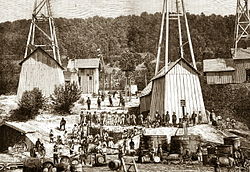Zręcin is a small village in the South East of Poland where Ignacy Łukasiewicz and his wife are buried. He was the inventor of kerosone lamp.
Ignacy Łukasiewicz was born on 8 March 1822 in Zaduszniki, near Mielec, in the Austrian Empire (after the partition of Poland) as the youngest of five children. His family had Armenian origins and his parents were Apolonia, née Świetlik, and Józef Łukasiewicz, a member of the localintelligentsia nobility entitled to use Łada coat of arms and a veteran of Kościuszko's Uprising. They rented a small manor in Zaduszniki, but soon after Ignacy's birth the family was forced to relocate to nearby city of Rzeszów due to financial difficulties. There Ignacy entered the local secondary school (Konarski's Gymnasium), but failed to pass the exams and left in 1836. In order to help his parents and financially support all of the relatives, he moved to Łańcut, where he began work as a pharmacist's assistant in a chemist. Towards the end of his life Łukasiewicz often described his childhood as happy; the atmosphere at home was patriotic and somewhat democratic and he commonly recalled his first tutor, Colonel Woysym-Antoniewicz, who was also a resident in their house.
Career as chemist
On 15 August 1848 he was employed at one of the biggest and best pharmacies in Austrian Galicia (so-called "Austrian Poland"); the Golden Star Pharmacy in Lwów, owned by Piotr Mikolasch. In 1850, a handheld pharmaceutical almanac and a precious document entitled manuskrypt, the joint work of Mikolasch and Łukasiewicz was published. Because of this achievement, the authorities granted him a permit to continue pharmaceutical studies at the Royal Jagiellonian University in Kraków. After several years of studies, financed mostly by Mikolasch, he passed all his university examinations except for that in pharmacognosy, which prevented him from graduating. Finally on 30 July 1852 Łukasiewicz graduated from the pharmacy department at the University of Vienna, where he earned a master's degree in pharmaceutics. As soon as he returned to the pharmacy of Piotr Mikolasch in Lwów, he began a new phase of his life devoted to the studies of exploiting kerosene.
Petroleum industry and oil lamp
While oil was known to exist for a long time in the Subcarpathian-Galician region, it was more commonly used as an animal drug and lubricant, but Łukasiewicz was the first person to distill the liquid in Poland and in the world and was able to exploit it for lighting and create a brand new industry. In autumn of 1852 Łukasiewicz, Mikolasch and his colleague John Zeh analyzed the oil, which was provided in a few barrels by traders from the town of Drohobycz. After pharmaceutical methods and processes the purified oil was obtained and sold in the local pharmacies, but the orders were small due to high prices. In early 1854 Łukasiewicz moved to Gorlice, where he continued his work. He set up many companies together with entrepreneurs and landowners. That same year, he opened the world's first oil "mine" at Bóbrka, near Krosno (still operational as of 2006). At the same time Łukasiewicz continued his work on kerosene lamps. Later that year, he set up the first kerosene street lamp in Gorlice's Zawodzie district. In subsequent years he opened several other oil wells, each as a joint venture with local merchants and businessmen. In 1856 in Ulaszowice, near Jasło, he opened an "oil distillery" — the world's first industrial oil refinery. As demand for kerosene was still low, the plant initially produced mostly artificial asphalt, machine oil, and lubricants. The refinery was destroyed in an 1859 fire, but was rebuilt at Polanka, nearKrosno, the following year.
Later life and death
By 1863 Łukasiewicz, who had moved to Jasło in 1858, was a wealthy man. He openly supported the January 1863 Uprising and financed help for refugees. In 1865 he bought a large manor and the village of Chorkówka. There he established yet another oil refinery. Having gained one of the largest fortunes in Galicia, Łukasiewicz promoted the development of the oil industry in the areas of Dukla and Gorlice. He gave his name to several oil-mining enterprises in the area, including oil wells at Ropianka, Wilsznia, Smereczne, Ropa, and Wójtowa. He also became a regional benefactor and founded a spa resort at Bóbrka, a chapel at Chorkówka, and a large church at Zręcin.(wiki)
Church in Zrecin - Lukasiewicz was his founder
 |
| Add caption |
Nearby the chuirch is a cementery where there is a grave of Łukasiewicz and his wife Honorata.
All photos I took last July..















Such a lovely church. I didn't know anything about this inventor.
ReplyDeletehe was European not American one
DeleteThe flat grave stones are interesting, unlike what we have here.
ReplyDeletegrave stones in Europe are completely diffeent from America
DeleteWell you had me at the first sentence as we share the same birthday - well not the year obviously! Fascinating.
ReplyDeleteWren x
So a lot of people have the same birthday...
DeleteHow fascinating. And the first oil baron also became rich, setting a pattern which has continued.
ReplyDeleteI love that he didn't forget to help others.
Yes he loved helping the poor
DeleteThank you Gosia for this history lesson. Very interesting indeed.
ReplyDeleteHistory stimulates the brain - well I am sure it helps my brain - ha ha.
Cheers
Colin
Colin so now you are better educated and your brain works perfectly
Deletei love the ceiling. what a great one to see ... lovely! ( ;
ReplyDeletehttp://hike2forty.blogspot.com/2016/08/820-inspired-sunday.html
The church is really nice
DeleteThat's a lovely church. I really like the architecture and the inside is so delicate and detailed. What a beautiful ceiling and windows! Wow! Thanks for the history, too.
ReplyDeletethe ceiling is really fantastic
DeleteGood to see they are renovating the church to extend it's life
ReplyDeletemy opinion is the same
Delete